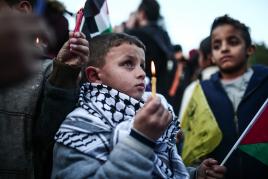
“A lifetime as refugees. The Israeli-Palestinian conflict and the tragedy of an exiled people” is the title of a Report featuring data and testimonies retracing the history of the Israeli-Palestinian conflict from the perspective of Palestinian refugees. The dossier was published today, on the occasion of World Refugee Day (20 June), by Caritas Italy, (, (Middle East and North Africa Office, MONA).
In 2021, reads the dossier, “Palestinian exiles extended to the third if not fourth generation.
Palestinian refugees, together with Syrians, are now the largest refugee group in the world”, while a “lasting and fair” solution to end their exile is still far from being achieved. Unresolved Arab-Palestinian-Israeli conflicts have made the Palestinian exile the most protracted in modern history.
Escalating numbers of Palestinian refugees. Millions. An estimated 5.6 million people live in Gaza, the West Bank, East Jerusalem, Jordan, Syria and Lebanon. Refugees include at least 1.5 million men, women and children living in 58 registered refugee camps in the Middle East region. Their hope, handed down “from father to son, grandfather to grandchild”, is to return to their homes someday, even if their homes have been demolished or are under Israeli control.
Who are those considered Palestinian “refugees”? Palestinian refugees are those persons of Arab origin (including their descendants) who were displaced from the territory once corresponding to Palestine under the British Mandate, in the process leading to the creation of the State of Israel (1947-1949) and in the subsequent conflicts (1967 Arab-Israeli war)”.
 Three categories. Palestinian refugees fall into three main categories, the largest of which “comprises those forced to flee their homes during the 1948 war and their descendants. This first category includes the estimated 5.6 million Palestinians who sought refuge in Gaza (1.46 million), the West Bank (859,000), Jordan (2.3 million), Syria (562,000) and Lebanon (476,000) and are recognised as refugees by the United Nations Relief and Works Agency for Palestine Refugees in the Near East (UNRWA), established in 1949. Under its mandate, UNRWA can only treat refugees (and their descendants) who fled in 1948, and not those displaced as a result of the 1967 war, the so-called Six-Day War. The latter fall under the protection of UNHCR, as stipulated in the 1951 Convention. In fact, the 1967 Arab-Israeli war triggered the Israeli occupation of the West Bank and the Gaza Strip, which continues to this day. However, it caused further flows of refugees ( 350,000 to 400,000 according to estimates) from the remaining parts of Palestine that were under Egyptian (Gaza Strip) and Jordanian (West Bank) authority. Those “displaced” during the 1967 war and their descendants (1.24 million) form the second largest category (thus not officially recognised as refugees), while the third comprises “an unidentified number” of Palestinians who do not fall under the previous two, but who were displaced outside the territory of Palestine as it was under the British Mandate.
Three categories. Palestinian refugees fall into three main categories, the largest of which “comprises those forced to flee their homes during the 1948 war and their descendants. This first category includes the estimated 5.6 million Palestinians who sought refuge in Gaza (1.46 million), the West Bank (859,000), Jordan (2.3 million), Syria (562,000) and Lebanon (476,000) and are recognised as refugees by the United Nations Relief and Works Agency for Palestine Refugees in the Near East (UNRWA), established in 1949. Under its mandate, UNRWA can only treat refugees (and their descendants) who fled in 1948, and not those displaced as a result of the 1967 war, the so-called Six-Day War. The latter fall under the protection of UNHCR, as stipulated in the 1951 Convention. In fact, the 1967 Arab-Israeli war triggered the Israeli occupation of the West Bank and the Gaza Strip, which continues to this day. However, it caused further flows of refugees ( 350,000 to 400,000 according to estimates) from the remaining parts of Palestine that were under Egyptian (Gaza Strip) and Jordanian (West Bank) authority. Those “displaced” during the 1967 war and their descendants (1.24 million) form the second largest category (thus not officially recognised as refugees), while the third comprises “an unidentified number” of Palestinians who do not fall under the previous two, but who were displaced outside the territory of Palestine as it was under the British Mandate.
Internally displaced Palestinians. There are two main categories of Palestinian ‘internally displaced persons’: those who were displaced from their homes without crossing international borders. The first category (415,876 persons) is composed of Palestinians (and their descendants) who were internally displaced after 1948 and remained within the then Palestinian borders. The second category (344,599 persons) is composed of Palestinians who have been internally displaced in the Occupied Territories since the 1967 war. The UNHCR, the Caritas Dossier explains, also “regards 115,649 Palestinians as a Population of Concern.” This figure includes 100,693 refugees, 13,439 asylum seekers, and 1,459 persons categorized as “Various.” This group includes a mixture of Palestinians displaced in 1948, 1967 and also refugees displaced outside these two major displacement events. These Palestinians fall under UNHCR’s mandate, as they are eligible under the 1951 Refugee Convention and fall outside of UNRWA’s area of operations; for example, 70,000 are Palestinians in Egypt, 8,000 are Palestinians in Iraq and 6,500 are Palestinians in Libya.
 Living conditions. Caritas reports a tragic situation with Palestinian refugees “victims of the wars in the Holy Land, victims of Israeli policies, victims of the loopholes in international law and also victims of the nations where they are received as unwanted guests. Nations that in turn are experiencing wars, crises and poverty that upset their social stability. And sadly, the liberation of the Palestinian people, who have been suffering for over 70 years, appears to be nowhere in sight.” Miserable living conditions in the refugee camps, marked by poverty and food insecurity, poor school education, inadequate health care and unemployment, attest to this situation. The fact that the Palestinian refugee population is young – around 25.5% of all registered refugees are under 15 years of age – highlights the dramatic nature of the problem.
Living conditions. Caritas reports a tragic situation with Palestinian refugees “victims of the wars in the Holy Land, victims of Israeli policies, victims of the loopholes in international law and also victims of the nations where they are received as unwanted guests. Nations that in turn are experiencing wars, crises and poverty that upset their social stability. And sadly, the liberation of the Palestinian people, who have been suffering for over 70 years, appears to be nowhere in sight.” Miserable living conditions in the refugee camps, marked by poverty and food insecurity, poor school education, inadequate health care and unemployment, attest to this situation. The fact that the Palestinian refugee population is young – around 25.5% of all registered refugees are under 15 years of age – highlights the dramatic nature of the problem.
The main obstacle. The absence of political will to resolve the underlying causes of the Palestinian refugee issue in compliance with international law remains the main obstacle, reads the Caritas Dossier. The situation, “has deteriorated further during the period of the Middle East peace process (1991-2000) and, in particular, with the Oslo Accords (1993-95). Since then, the solution to the refugee problem, while continuing to be recognised as an international and, notably, UN concern since the late 1940s, started to be treated as an issue to be resolved in negotiations between Israelis and Palestinians. The imbalance of power between the two sides, coupled with Israel’s unresolved territorial ambitions over the land that is to become the State of Palestine, is preventing all solutions to the refugee situation.”
The proposals. In its Report, Caritas Italy presents five proposals directed at the international community and the Italian government to resolve the Palestinian refugee problem:
“respect for international law; Italy and the other EU countries should officially recognise the State of Palestine; stop the sale of arms, including from Italy; financing peace; not just hate. Change communication strategy”.
“Diplomatic efforts for peace and respect for international law are needed in Palestine, which can no longer be postponed. Palestinians remain the single largest group of stateless refugees in the world: people without an officially recognised sovereign state that safeguards their rights and is accountable to their citizens and the international community”, states the Report. For Caritas Italy
“ now more than ever it is necessary for other countries, including and above all Italy, to join Sweden and the Vatican City in the recognition of the State of Palestine, as a foundation for resolving the Palestinian refugees’ plight.”
“One valid deterrent to the escalation of conflicts, hence to new refugees, is the prohibition of arms sales, and specifically to Israelis and Palestinians, the warring parties.” Caritas thus calls for “the immediate cessation of all arms supplies to Israel and the revocation of all current arms concessions.” Caritas’ proposal is to put down the weapons and finance peace to ensure the return of Palestinian refugees to their lands. This must be a joint process involving the entire international community and reject the narrative of hatred concerning Palestinian refugees and the two peoples involved in an over 70-year-long conflict. In spite of everything, Caritas Italy concludes, “there is a glimmer of hope for peaceful coexistence. But that hope must be sustained, upheld and encouraged. It needs to blossom in the people, inside communities and thereby in the respective governments of Israel and Palestine.”










